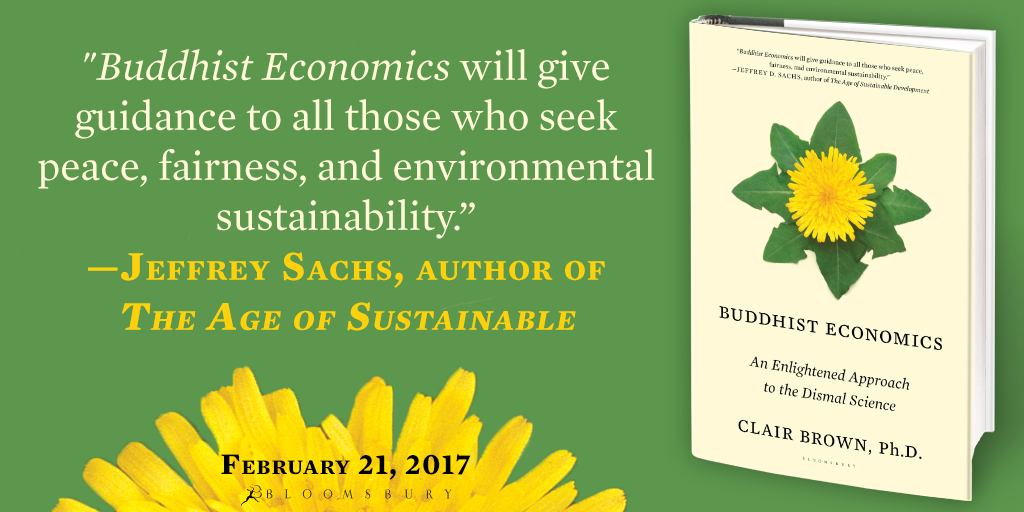This week’s blog is from an interview with an Italian reporter.
My book is being published by Italian publisher Vallardi, an imprint of Gruppo Editoriale Mauri Spagno (part of Penguin Random House).
BUDDHIST ECONOMICS is part of their bestselling Sakura line about Zen & Japanese philosophy and way of life.
My book trailer (2 min), https://youtu.be/88RX5A2iezs has Italian closed captions.
What are the basic principles of Buddhist Economics?
Buddhist economics assumes that people are interdependent with each other, and people are interdependent with nature. These assumptions immediately lead to outcomes where shared prosperity and sustainability improve social welfare because one person’s well-being is affected by everyone else’s well-being and by the well-being of nature (the planet). Think of Indra’s Net, which is an infinite net with a jewel at each intersection, so each jewel reflects what is happening in all the other jewels. This is the infinite interdependence of Buddhist Economics!
Free market economics focuses on efficiency, or the size of the pie produced (national income). Most economists also care about inequality, or the division of the pie (distribution of income). Buddhist economics also cares about how people live, or what is in the pie (all output and activities that create a meaningful comfortable life and care for nature).
What are the main differences between Buddhist economics and Free Market economics or Socialist economics?
Economic systems present a variety of capitalism, as taught by political scientists. The role of the government is to structure markets to achieve specific social outcomes. Each society chooses their inequality and their carbon emissions (pollution), as well as how many people are suffering from poverty or inadequate health care. The government can be minimalist, as in Free Market Economy where the government enforces rule of law, property rights, and national security. Or the government can be activist, as in Social Democracies that structure markets in order to reduce poverty; provide social services such as child care, health care, and education; limit discrimination; and administer a social safety net. A Buddhist economy is a market economy where the government plays an important role in structuring markets so that everyone can live a comfortable, meaningful life in a sustainable world.
What are the policies supported by Buddhist Economics compared to Free Market Economics? Are these policies already being applied by some countries?
Free market economics ignores inequality and pollution, because these problems are assumed away, which means they are denied.
Buddhist economics looks to policies that have been used in many countries that effectively reduce inequality, and my book mentions some of them, such as higher minimum wages, laws that strengthen unions and workers’ bargaining power, more progressive income taxes (taxes that increase as income increases) with a top rate of 65 percent, more progressive inheritance taxes, adequate health care and education, child benefits, and mandated vacation days, overtime pay, and family care leave.
Buddhist economics also relies on available technology to transition from dependence on fossil fuel energy to a clean energy economy that is modern and affordable. Scientists have provided two road maps that show how countries can meet the Paris 2015 global warming target of < 2 degrees centigrade by implementing 75%-100% renewable energy by 2050 (see Stanford’s 100% clean energy http://thesolutionsproject.org/; UN’s Deep Decarbonization Pathways Project http://deepdecarbonization.org/).
How does Buddhist Economics evaluate and measure economic growth?
A critical part of Buddhist Economics is measuring economic growth in a holistic way that looks at the quality of life provided to all people and the health of the environment, because what we measure indicates what we value and lays out the path for the economy.
One chapter of the book explains various approaches used by economists to measure economic performance as quality of life. Economists agree that average national output (Gross Domestic Product, GDP) is not a good measure of a country’s economic well-being because only what is sold in the marketplace is included in GDP, and all other human activities are ignored. Yet GDP is used to measure economic performance around the world. Economists have created several ways to measure pollution and environmental damage, income inequality, happiness, human capabilities, and nonpaid activities (both useful and harmful). These metrics have been used to create various holistic measures of economic performance, such as the UN’s Human Development Index, the OECD Better Life Index, the Genuine Progress Indicator, the Happy Planet Index, and Bhutan’s Gross National Happiness Index. Buddhist Economics relies on these measures, and any one of them is better than using the GDP.
What are the steps to implement a Buddhist economy in a Western country? To what extent does it require a change of perspective, and what motivates this change?
The last chapter pulls together the Buddhist economics framework and lays out eight steps to make the leap to a Buddhist economy: four steps for the country, two steps for business, and two steps for people. The major change in perspective for a rich country, like the OECD nations, is to focus on the quality of life of everyone and go beyond consumerism to create happiness and a better world. Our perspective shifts from a focus on chasing after more income to creating a meaningful life and preserving nature. In a Buddhist economy, “Practice compassion to be happy” replaces “More is better,” and “Everyone’s well-being is connected” replaces “Maximize your own position.” Our motivation is that we are dissatisfied and want to have a more meaningful life; we want to get off the materialistic treadmill and enjoy the relationships and experiences that make us happy; we want to pass along a healthy planet to future generations.
